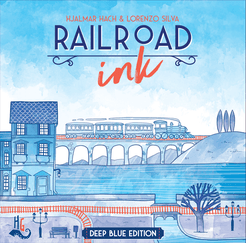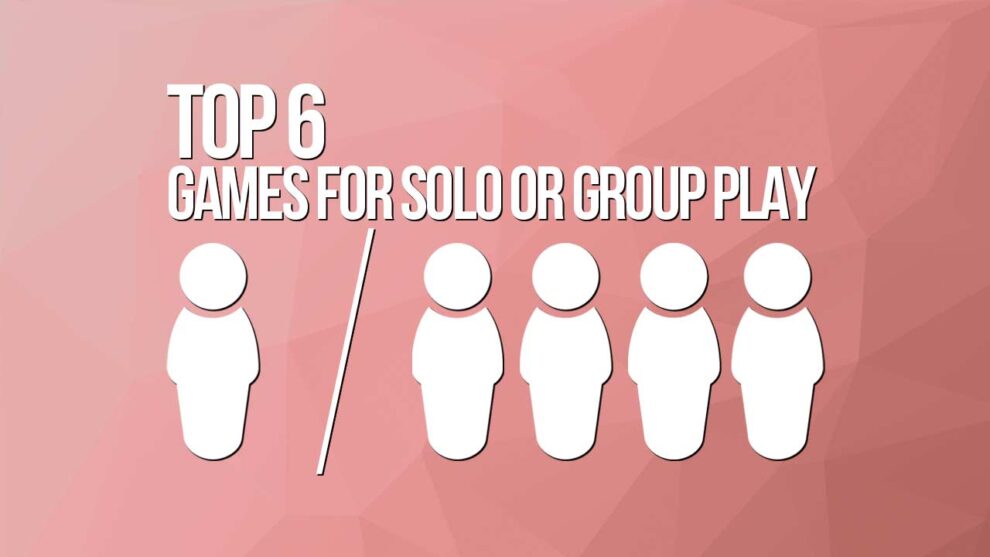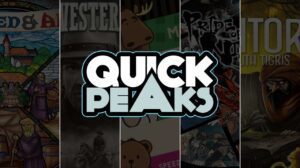That question is the basis of today’s thought experiment. It is a bit tougher to answer than it might seem at first. Any games that were designed to be played solo, but which have to alter the rules in a significant way in order to allow more players are not the sort of thing we are talking about. Conversely, games designed to be played with multiple players, but which have a solo mode that alters the rules in a significant way—including adding an artificial player that does not follow the same rules as you—also fail to meet the criteria being discussed.
So what is left? Turns out, not a whole lot. Below you will find six games that range from multiplayer solitaire, to games where the interactions you have are indirect and subtle, but still meaningful. In each of these games, the fundamental rules do not change, but sometimes shifting player count causes the implications of those rules to morph in unexpected ways. So let’s look at six examples of games that fit our criteria.

#1: Yahtzee
Yahtzee is a game about making poker-like sets with dice. The scoreboard is broken into two parts: the upper part scores for each of the die faces (ones, twos, etc.) with a bonus if you can meet a minimum score; the lower part has the poker hands (three-of-a-kind, four-of-a-kind, full houses, straights, etc.) and the yahtzee (five-of-a-kind).
Yahtzee is a game that is great solo primarily because you are playing solo, even if there are a dozen other players. Your turn is your turn. There is nothing anyone can do on your turn to impact anything that you are doing, and there is nothing you can do during or between your turns to impact anything that anyone else is doing. That said, it can be a decent way to pass the time. All you need are five standard dice and you are ready to go.
Variations on Yahtzee include Triple Yahtzee (playing three games at once), Word Yahtzee (Yahtzee + Scrabble), and a host of themed sets from Dragon Ball Z to Guardians of the Galaxy. The core concepts in this game are basic and strong enough to allow for a lot of customization without ever becoming something other than Yahtzee. Whether this is a good thing or not, I will leave to the reader.
It is hard to say what the extent of Yahtzee’s influence is, but it is likely quite extensive. Consider games like King of Tokyo or Catan Dice Game where the player is allowed to roll dice, keep some and re-roll others, then do that again. That ‘you get three chances’ mechanism is pure Yahtzee.
What happens when you shift from solo to multiplayer mode? Nothing at all. Since each player is playing an independent game with no impact on any other player, the game is exactly the same solo as it is with others. The one major difference is that with multiple players, traditionally, each player is taking a turn while everyone else waits. Since the dice are not common to each player when rolled, simultaneous turns are not the norm (presumably so that other players can watch the active player to keep them honest).
Winning? In multiplayer mode, the highest score wins. In the solo mode, there is no win condition. You are just trying to score as many points as possible and compare that to your previous games. This can be a serious drawback for some.
Method: Sequential play with independent resources; requires a lot of luck and some risk taking.

#2: Railroad Ink
Railroad Ink is a game about rolling special dice which have configurations of roads and rail pictured on each face. On each round, four dice are rolled and each player attempts to place the configurations into their 7×7 player board in a way that will maximize their point-generating potential.
For example, on the outer edges of the board there are 12 connections (six roads and six rail); getting as many of these connected as possible is the main way to get points. But there are others: getting long stretches of road, long stretches of rail, elements drawn in the inner nine-squares, avoiding having road or rail that just ends without anything in which to connect.
Railroad Ink is a beautiful game, and plays very quickly. The two base sets (Blazing Red and Deep Blue) do not differ in any way as far as the basic game is concerned. What changes are the options available for the included add-on dice. Blazing Red has options for meteor strikes or lava pools; Deep Blue has options for adding rivers or lakes. Each add-on is interesting and adds more decision space to the game.
If you want a more advanced version, you can move on to Railroad Ink Challenge, which comes in two flavors as well, alters the dice, adds more scoring options, and comes with their own optional dice: Lush Green has options for adding trails or forests; Shining Yellow has options for adding deserts or canyons.
As if this were not enough variety, there are other sets of expansion dice that can be used with either of the original or challenge editions. These sets include adding underground elements, including video-game elements, and more. If you get into this, you are years from boredom.
What happens when you shift from solo to multiplayer mode? Nothing at all. Every player is using the same dice. Nothing one player does has any impact on another. Scores at the end are compared, and the player that scored the most points wins. Winning a multiplayer game is not just about getting luckier than the others, it is about planning your routes better.
Winning? In multiplayer mode, the highest score wins. In the solo mode, there is no win condition. You are just trying to score as many points as possible and compare that to your previous games. As with Yahtzee (above), this can be a serious drawback for some.
Method? Simultaneous play with the same resources; requires efficient use of what is available.

#3: Welcome to…
Welcome to… is a game about building a small neighborhood. It is a flip-and-write—you are presented with cards that have house numbers on one side and actions on the other. House numbers on each street need to keep moving in an ascending order, and actions can be used to put up fences, install swimming pools, build parks, invest into the housing markets, and so on. In the base game, you deal out three three pairs of cards each round. If you select one card in a pair for its house number, you are locked into using its companion for the action it is showing.
There are optional rules for round-abouts, which split a street into two parts. Each part of the street follows its own house number sequence (but round-abours cost you points to use them).
In addition to the basic points, each game has three randomly selected goals that can direct your play in one direction or another. The goal cards have two point values. The first, higher, value is granted to the first player to complete it. All players that complete the goal after that get the second, lower, bonus. The cards are flipped over to a side that shows that the first value is no longer available.
As you can see, the game is designed to be played multiplayer. In multiplayer mode, there are additional options for how the cards are dealt which can remove the shared nature of the cards in play. That option is not used when playing solo. The game has several themed neighborhood boards that can add in some additional elements: fighting off a zombie hoard, putting up Christmas lights, and so on. Welcome to… is one of those games that comes along and challenges you on many levels.
What happens when you shift from multiplayer to solo mode? Gameplay does not change. You still have three goals, and the cards are coming into play the same way. What changes is a special solo game card is shuffled into the deck. When this card is revealed, any goal card that has not yet been completed is flipped as though some other player had completed them. Thus, instead of racing your opponents to get the higher bonuses, you are racing a clock built into the deck. From a rules perspective, nothing really changes at all.
Winning? In multiplayer mode, the highest score wins. In the solo mode, there is no win condition. You are just trying to score as many points as possible and compare that to your previous games. As above, this can be a serious drawback for some.
Method? Simultaneous play with the same resources or with independent resources; requires efficient use of what is available.

#4: Sagrada
Sagrada is a game about making stained-glass windows. You make these windows using various dice of different colors. When completing your window, you need to position the colors and face values based on restrictions and goals. Depending upon how the game is set up and what spaces you need to fill in your window, you might prefer a specific color or number over another. This preference will often shift from round to round.
Each round involves choosing a die from a common pool of dice available for that round (two dice per player, plus one); this means that if your opponent claims a die, you cannot have it (and vice versa). Each round consists of players making two such choices and plays. The unused die goes into the round track. This interaction is indirect and sometimes quite subtle, but it can result in some hate-drafting. To help deal with the randomness, players have access to a set of randomly selected tools. Each tool can only be used by each player once and at a modest cost; a few of them interact with the dice on the round track.
Sagrada is a wonderful game to play with friends. Playing solo is one of those experiences that can create actual anxiety (see below). The game is tense, tough, and a lot of fun as you attempt to crack the nut that is the most efficient use of the dice presented to you.
What happens when you shift from multiplayer to solo mode? Not much. There is an extra die presented to you (so four, two dice per player, plus two). You are given a number of tools to use (based on how difficult you want the game to be); each is paid for a little differently, but they still cost you to use them. Each round you choose two of these one at a time, just as you would in a multiplayer game. The two unused dice go onto the round track. And this is where the game gets vicious!
Winning: In the multiplayer mode, the player with the most points wins. In solo mode, you are presented with one of the most diabolical target scores in gaming. All those dice you put onto the round tracker? Add their values together and this becomes the target score. If you scored this number of points or less, you lose. Only if you beat that value do you win. This makes some of the choices you make as to which dice to use, or when to use a tool so much harder. I mean, who wants to put two sixes on the round tracker when that means having to get 12 more points in order to win?
Method: Sequential play with a common pool of resources; requires a mixture of luck, planning, and skill.

#5: MicroMacro: Crime City
MicroMacro is a cooperative game about crime. Lots of crimes, actually. Each one is a case that needs to be solved. To solve the case, you are first given some info about what happened and perhaps a single prompting clue to get you started. The game board is a hand-drawn map of the city (called Crime City).
This map is special, however! It includes not just the streets and buildings, but it is a snapshot of the people who reside there. Oddly, however (and this is important), it is not a snapshot at one particular time. As you scan over the people of the city, you will see where a character was and what they were doing at different times all through the day the crime took place. So as you go from clue to clue, you need to trace the movements of the character(s) involved in order to find out how and why they did the bad deed that they did.
As you discover and learn about each new clue, more cards in the case are revealed to prompt you to the next part of the case until all of the questions are answered and justice is served. Or the player(s) give up.
The base game comes with over a dozen cases. More are available if you want them from the BGG Store as well as some expansion packs they sold. Once you complete all the cases, the entire game is still in a condition where it can be passed along to someone else for them to fully enjoy. If you want to solve some more cases, other base games were released including Full House, All-In, Showdown, and so on.
What happens when you shift from solo to multiplayer mode? Nothing from a rules perspective. The only thing that changes is the number of eyes looking for clues. You might think having one person looking would make things harder than it is with five. And in some ways, you would be right. But having five increases the number of ways people can interpret what they are seeing. The discussions that come up trying to make sense of this symbol on a poster, or the fact that someone believes that this other person seems to always be nearby can create a different experience playing the game. Either way you play, the cases can be relatively simple (taking a half-hour or less to solve), all the way up to mind-boggling (taking a couple of hours or more). Tracking a character when they have access to the subway can be taxing.
Winning? In multiplayer mode, getting through all of the layers and solving the case means you won; failing to solve the case means you lost. In solo mode, this does not change at all. Either you solved the case or you didn’t. Pretty straight forward.
Method: Simultaneous cooperative play.

#6: That’s Pretty Clever!
Ganz schon clever (German for That’s Pretty Clever) is an award winning roll-and-write dice game that has been compared to Yahtzee. This is an unfair comparison—Yahtzee this ain’t. In this game, players roll six color-coded dice (yellow, blue, green, orange, purple, and a white die that can be used as any color) and select one to be set aside and used in the designated color-coded area of their scorepad. They do this three times on a turn. The kicker here is multi-faceted: when a die is chosen, any dice that is lower in value are lost and cannot be used for the rest of the turn. At the end of the turn, any dice that were not used are on a silver platter and are available to the other players who may select one and score it. Depending upon where they score, they may earn bonuses from re-rolls, the ability to use extra dice in a turn, and even a special scoring bonus called a Fox which multiplies a section’s score.
On the surface, these two considerations may not seem all that impressive. In practice, when added to how each section scores, they are very impressive, indeed. The final score for each player is the sum of the scores for each of the five sections, plus the Fox bonus (if any).
What happens when you shift from solo to multiplayer mode? The game plays the same solo and multiplayer. Each round, the solo player will be the active player once (making rolls and choices as described above), and the passive player once (generating a set of values and putting the three lowest values on the silver platter).
Winning? In the multiplayer mode, the player with the most points wins. In solo play, there is a point scale presented that will rank you from Try harder to You’re so clever. So yea, there is no win condition. You are just trying to score as many points as possible. As above, this can be a serious drawback for some.
Method: Sequential play with interdependent resources; although there is luck involved, there are a lot of tools that can mitigate that.
Final Thoughts
So how did this thought experiment turn out? I would call this a success! What we ended up with are six games that can be enjoyed alone or with friends without having to create artificial opponents or having to rewrite whole sections of the rulebook. Do you disagree with any of these? What games would you, dear reader, add to this list? Let me know in the comments.

















Add Comment